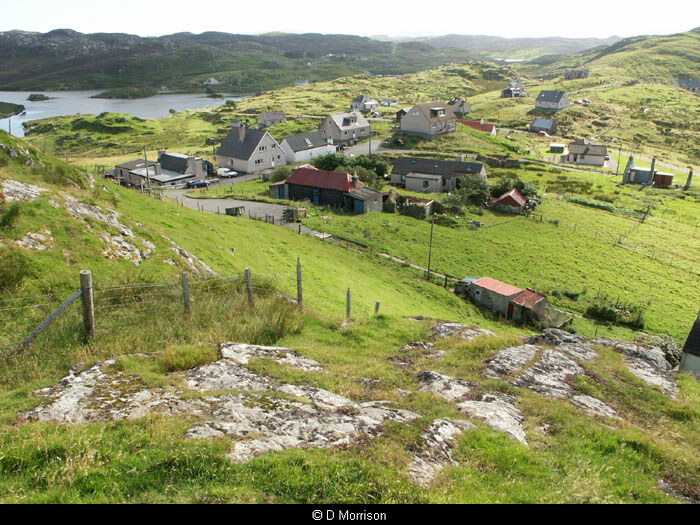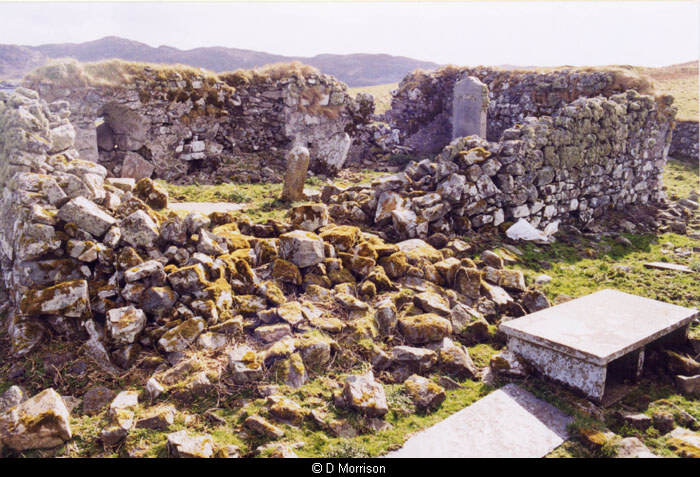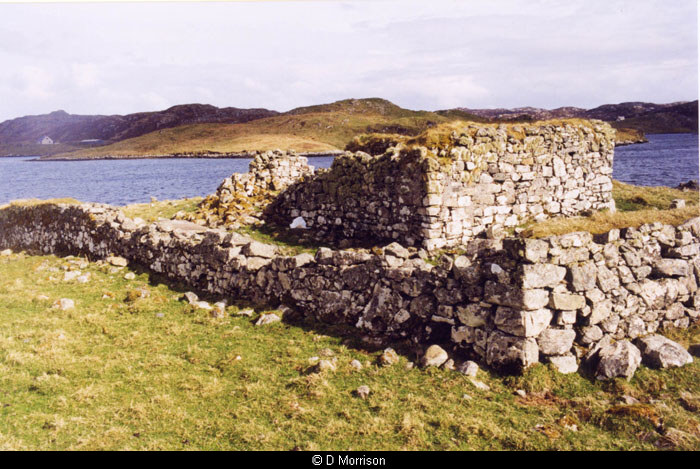47171: St Colm’s Isle, Cromore and Crobeg
An account of the island, its namesake and the neighbouring villages by Angus "Ease" Macleod, Calbost and Marybank; from Tional, June 1993
St Columba was at the head of a very successful missionary effort that evangelised the whole of Scotland and his Celtic Church, which was after the Presbyterian fashion and said to be very Scriptural in Doctrine, prevailed as the National Church for 150 years. Our own present Presbyterian Churches claim direct descent from the Celtic Church, a branch of which was at one time planted in St. Colm in Loch Erisort. Likewise the ancient Gaelic-speaking Celts of Dalriada built on the work of Columba and subsequently united our divided land under one King and gave it their own name, Scotland.
St. Columba, sometimes known as the Apostle of the Western Highlands, was born in Ireland in 521 AD and died in Iona in 597. He and twelve disciples sailed from Derry in Ireland in 563 AD in a frail coracle made of branches and covered with fresh hides which were lashed to the gunwale with leather thongs. They landed in the small green Island of Iona on 12th May, 563 AD and at the age of 42 years he began his life’s main work of evangelising Scotland.
In time Columba’s followers penetrated through to the North of Scotland, and Applecross on the Minch Coast became the Iona of the North. At sometime before 800 AD the influence of the Celtic Church spread to Lewis. Then, as now, the outward trappings of religion was sometimes more important in the eyes of some people than the substance of Religion and an argument arose between the Roman Catholic Church and the Celtic Church over the correct date of Easter and the correct way to shave the heads of the Clergy. Eventually the stronger Roman Catholic Church prevailed and the influence of the Celtic Church on the mainland of Scotland waned.
Eilean Chaluim Cille is worthy of a visit in order to see the ruins of the old place of worship that is still visible there and to reflect on the branch of the Celtic Church that functioned there upwards of 1,200 years ago and probably for hundreds of years thereafter. It is however difficult to pinpoint a date at which the Celtic Church ceased to exist at Eilean Challum Cille. It is more likely that seeing it was in a remote place, it continued to function as before, long after the mother church at Iona ceased to function.
The first valuable account we have of Lewis is from the pen of Sir Donald Munro who had been Rector of St. Colm at Eye (Point) and as Archdeacon of the Isles came to inspect and report on the religious houses of the area in 1549. His referred to St Colm’s Island in Loch Erisort
Within this Isle Macleod of Lewis has ane faire orchard, and he that is gardener has that Isle free, guid in Mayne land for corne, and grassing and fishing, pertaining to Macleod of Lewis.
According to Sir Donald Munro the Isle of St. Colm seems to be in the possession of the gardener and he does not mention the Church. Does that mean that the Church had ceased to function then, shortly before the Reformation?
In 1695 Martin Martin listed the Church of St. Colm Cille in the island of that name in Lochs as one of the 20 or 30 pre-Reformation Churches in Lewis. Reference is made by Rev Robert Finlayson, Church of Scotland minister at Keose in his statistical return in 1833, about the ruin of a place of Worship on St. Colm Island in Loch Erisort, which he says was erected in the days of "Mac ic Mhurchaidh", referring to the first Factor of Seaforth in Lewis and Seaforth came in 1610. Obviously Rev Finlayson, who had only arrived in Keose shortly before that, was misinformed. The more likely thing is that Seaforth in the post Reformation period repaired the pre-Reformation Celtic Church of St. Colm.
There is little doubt that the ruins we still see in Eilean Chaluim Cille are the ruins of the original Church of the followers of St. Colm. An entry in the records of the Royal Commission on Ancient Monuments of Scotland, states
this church stands in a graveyard on the South-eastern shore of Eilean Challum Cille in Loch Erisort. It is oblong in plan and measures internally 29 feet 6 inches by 13 feet 3 inches. The walls, still standing to an average height of 6 feet and measuring 2 feet 6 inches thick. It is orientated almost due East and West. The door is about the middle of the North wall. A widely splayed window with rounded top and built up externally, opens in the South wall 2 feet 6 inches from the East end. No other window can now be traced.
The agile among us might resolve to explore the secrets and mysteries of Eilean Challum Chille. To that end we would put forward some points raised by Donald Mackay, Kershader, in the Gazette some years ago, as strong evidence pointing to the probability that the ecclesiastical foundation at St. Colm Island extended across to the mainland of Crobeg and Cromore at one time. He quoted a 94-year-old lady from Cromore who maintained always that the ruins of buildings on the seashore near "Buala Fherinish", which is a beautiful green sward across "Caolais-an-Eilean" on the mainland of Crobeg was the site of the residence of the Priest of St. Colm.
Some of the local people however maintained that the more likely place for the residence of the Priest was the buildings in a secluded spot beside the seashore near "Meall-an-Eoin" on the Crobeg mainland.
Mr Mackay also raised the likelihood that the stretches of tumble down walls adjoining Buala Fherinish evidentally enclosed extensive Gardens at one time. It is tantalising to think that holy men of old tenderly attended to fruit trees and flowers and vegetables on the shores of Loch Erisort where the warm currents of the Gulf stream produced results comparable to the Inverewe Gardens on the other side of the Minch.
In the middle of Cromore there are long stretches of arable land and on Croft No. 5 there was a walled garden known traditionally as "Leis-an-Theambuill", The Garden of the Temple. Unfortunately the stones of that Garden Wall were removed about the end of the 19th Century but the location is familiar to everyone in the village. As there is no local tradition of a Temple nearby we feel it is reasonable to conclude that this Garden pertained to the Temple on the Isle of St. Colm.
The Columban monks obviously introduced various, things to the areas they settled in because they were self-sufficient. They would obviously be very good agriculturalists and aorticulturalists and would introduce all manner of fruit trees, gardens plants and advanced agricultural methods.
Probably they used the old Norwegian type mill on the stream at Torostay. It is the nearest sizeable stream to St. Colm’s Island. Probably they would have a resident miller there. We must remember that the population of Lewis at that time was only in the region of 4,000 persons and there would not be the same pressure for living space as there was later.
Loch Erisort would be teeming with fish at that time yet the monks introduced Grey Mullet (geada) to a freshwater loch to the east of Cromore, ‘Loch na Bodach’. They must have been fond of sport or relaxation. That fish is still there.
When we consider the observation of Doctor MacDonald in his book, Tales and Traditions of the Lews, that, because of the fertility of the soil of Eilean Challum Chille, Macleod of Lewis used it as an orchard, market garden and granary. Probably the whole area of St Colm, Crobeg, Cromore and even Torostay was included in a farm and Macleod of Lewis was only continuing the work of the monks in the area. The Macleods held Lewis for a few hundred years before Seaforth Mackenzie came in 1610. It would be very convenient for Macleod to transport the produce from St. Colm’s farm to the old Castle in Stornoway Bay, by sea, direct to the door.
The Scottish Reformation took place in 1560 and the laudable aim of the Reformers was to establish a Church and School in every Parish. It was some time before the Presbyterian Parish Church came to Lochs and when it did it was a thatched Church and Manse built at "Tob Shuardail" near Keose on the shores of Loch Erisort in 1724. Later on the Parish Church was moved into Keose on to the site of the seaweed factory in 1796.
Many of us look forward to visiting this old cemetery which was still in use in the late 19th Century and we think on occasion during the early part of this century. Probably we all have ancestors buried here. The Crossbost, Gravir and Laxay Cemetery are comparatively recent and it was the St. Colm Cemetery that was the main cemetery in Lochs before then. The oldest of the above three cemeteries was not established until some time after the disruption in 1843 when the whole of the Lochs Parish congregation at Keose went into the new Free Church at Crossbost. Certainly there was an older cemetery at Crossbost on the North side of the main road. Rev Robert Finlayson, in his Statistical Report in 1833, states that the ground surrounding the Church ruin at St. Colm is the only place of interment in the Parish of Lochs.
We read about the first Seaforth Factor in Lewis as being <<41654##"Mac Mhic Mhurchaidh">> and that he lived in St. Colm, Loch Erisort. We also read about "Macneill an Eillean" who was also a Seaforth Factor, at St Colm. It was his son, Captain MacNeill, that commanded the vessel that was built at Cuireseal at Kebbock Head in the Race across the Atlantic.
In the Rental for 1718 the name of Alex MacKenzie appears as Tacksman at St. Colm. Mr Gillanders, the Lewis Estate Factor, held St. Colm from 1776 to 1795 in the same way as he did various other places in Lewis. He probably sub-let them to others. Mr Gillanders left Lewis a rich man and he bought an Estate for himself on the mainland and developed into a fully fledged Highland Laird. When in Lewis he had a monopoly of the trade in Black Cattle and the fisheries.
CROBEG
In time Crobeg became the centre of the Tack and Allan ‘Ruadh’ Ross, born about 1730, is the first Crobeg Tacksman that we know about. He was married to a sister of Evander Maciver, the Tacksman at Gress. Allan Ruadh was followed by his son, Roderick, bom about 1758 and we know about a family of two sons and two daughters. Ishbel Ross was the mother of Matilda that married Tormod Og Calbost in romantic circumstances. Kenneth Ross (1800-1862) was a highly respected lay preacher at Carloway. Allan Ross (1803 -1870) was a school teacher at the Parish school in Lochs. Catriona was married to Mr Macfarlane.
There were several other Tacksmen down to the present day when the family of Charles Macleod, Steinish, farms the place.
CROMORE
Towards the end of the 18th Century the villages of Park were occupied by Tacksmen and small holders who held their land from Tacksmen under the old clan system of land tenure known as Run-Rig.
Rory Ross is listed as the Tacksman at Cromore in 1810, and in 1814 Mrs Ross and her son was given as the Tackspersons. We know that the Rosses lived at Crobeag and held the Tacks of Crobeg as well as St. Colm Island.
There are indications that the Tack, which was probably designated as St. Colm Island, or Crobeg, from time to time, extended to the mainland and took in Torostay as well as Caverstay and obviously Cromore. When the Seaforth Factors lived at St. Colm Island, no doubt a large area of the mainland went with the St. Colm Tack.
It is evident from the ancient monument or Dun, sometimes known as "Dun Ban", the ruins of which may still be seen on an inlet in the Brackish-Water loch in the middle of Cromore, that people resided in this area long ago in Pictish times.
A description of the Cromore Broch stated that it is oval in plan with axes 52 feet and 44 feet and the walls varied from 7 feet to 10 feet 9 inches in thickness. It was connected to the mainland by a causeway which is still visible underwater. The walls rose to a great height. A two-foot wide gallery in the southern wall had a stair of 17 steps leading to a third gallery and underneath them a similar stair leading down to a gallery, but with no exit. Unfortunately there is no evidence of these stairs and very little of the walls are left now.
Pairc Historical Society
Details
- Record Type:
- Story, Report or Tradition
- Record Maintained by:
- CEP


